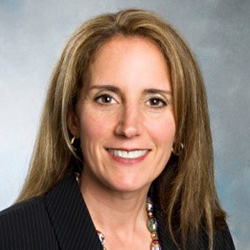
Getty Images/iStockphoto
Charting the Future of Patient Experience and Technology
Connected health swooped in to define the patient experience during the pandemic, but as healthcare moves forward it must remember that quality healthcare goes beyond tech.
In just the year since the first coronavirus death was recorded in the United States, the healthcare industry has seen remarkable change. Now, as promising vaccines reveal a light at the end of the COVID-19 tunnel, medical experts are grappling with what comes next for the healthcare and patient experience.
The unprecedented nature of a global pandemic pushed every walk of life—even the medical industry—to innovate creative ways to carry on. After all, up until 2020 medicine was built on a very traditional, in-person model.
The industry was known for lagging behind its peers in other consumer sectors with technology adoption and innovation, instead continuing a model of in-office care, punctuated by front desk interactions and even paper forms.
“In 2020, the biggest thing for most of us was it was not something we were prepared for,” said Jason Fish, an internal medicine doctor and the chief medical officer and senior vice president at Southwestern Health Resources (SWHR). “What I do think made it also more difficult is that traditional healthcare wasn't able to meet the need.”
The pandemic turned all of that on its head as social distancing protocol and stay-at-home orders shuttered the doors to non-emergency care access and made patients experiencing even the most pressing of symptoms to forego care.

“You know from the data that there's been a number of people who have died at home. There's been delayed care and so delayed diagnoses are inevitable,” Fish pointed out.
“Fear drove a lot of that, but it was also the healthcare industry really struggling to figure out how to meet these needs while trying to figure out how to deal with the pandemic,” Fish continued. “The good thing that came out of that was innovation. Which is, I think when we talk about 2021, what we're going to see.”
An influx of telehealth visits. Health IT infrastructure that lets patients skip the waiting room and check in from their cars. Remote patient monitoring. These tools took up the lion’s share of the conversation around pandemic-era innovation, and rightfully so. They helped clinicians stay connected to their patients when they otherwise couldn’t, and what’s more, these tools are what patients want.
Most of the data coming out of the first wave of the pandemic, when telehealth use saw its initial spike, suggested patients liked it. In June, 83 percent of patients said they planned to use telehealth even after the pandemic subsides and in-person care returns to some semblance of normal.
But some experts caution against a future that is overly defined by patient engagement technology. Between a prevailing patient preference for genuine interpersonal connection and a digital divide that threatens to perpetuate already dangerous health disparities, some experts say a multimodal approach that leverages community health partnership and community-based care will be key.
“I saw healthcare leaning into consumer concerns around access and safety and innovation in ways that I'd never seen with the speed that we didn’t used to get from a healthcare industry perspective,” said Chrissy Daniels, MS, the chief experience officer at Press Ganey. “But I also saw all of our communities taking a step back and realizing that we have taken our access to high-quality, safe, patient-centered care for granted.”
“People saw the level of professionalism and human commitment that our physicians and other caregivers were making to keep us alive, and I don't think that will be forgotten.”
Healthcare needs to move forward with both of those truths at the forefront, remembering that technology can play a big role in shaping how patients engage in care, but that it’s the community presence of medicine that can redefine the experience.
Carving out a place for long-term telehealth use, at-home care
Part of that journey to reconfigure healthcare and meet patient needs was the transition to more technology-based care. Telehealth and remote patient monitoring saw a boom during the pandemic. Between February and April of 2020, telehealth visits jumped from being 0.1 to 43 percent of primary care visits, per HHS. And moving forward, nearly every expert agrees it will play a big role in patient experience.
That is largely because telehealth and remote patient monitoring were convenient for patients, allowing them to visit with their providers for minor check-ins from the comfort of their own homes. Patients no longer had to coordinate office visits around their work or childcare schedules, and they didn’t have to travel to, let alone find parking at, their doctors’ office.
And telehealth had its benefits on the clinician side, too.
“You get a chance in these visits to see where there potentially are social determinants of health that may be playing themselves out,” Fish pointed out. “During the office visits, you don't necessarily know any of that. You can ask about it, but you may not necessarily get the most honest answers sometimes. Patients don't necessarily want to share some of those things, they want to keep it objective or to some degree maintain a certain persona.”
But as healthcare prepares for a future that very much so involves telehealth and other technology options, it’s going to have to retool the traditional care delivery model. Telehealth is not simply using a video chat to run a medical visit; providers need to rethink how this tool fits into the overall patient experience and clinic operation.
“Because flipping from a face-to-face visit into a telehealth visit and then back into a face-to-face visit is a little bit difficult,” Fish pointed out.
Take, for example, an in-person visit that goes over a little bit. That leaves a telehealth patient in the virtual “waiting room” unaware of why her visit has not yet begun.
Fish recommended healthcare organizations rethink how they build out their schedules with telehealth and in-person visits. Segmenting a provider’s day into in-person consults and telehealth could help alleviate some of the pressure, padding the transition with some time should visits go over.
And getting more to the heart of the encounter, clinicians will also have to rethink how they connect with their patients via telehealth and other remote visit technologies. After all, patients foremost value having a clinician who genuinely cares for them, pandemic or not.

“There's an enduring truth about what patients are looking for, whether it was before the pandemic or during the pandemic, and that is patients are really looking for a meaningful interaction with their provider,” according to David Betts, a principal at Deloitte. “They want a physician or a clinician to listen to them, to spend time with them, to help them understand their condition, and to engage with them effectively in solving their problems.”
In that way, some of the prevailing challenges in patient engagement and experience will continue into the future, Betts added. And in fact, telehealth and the rise of digital engagement may have even heightened those concerns. A clinician worried about deeply and empathically connecting with her patient may be even more concerned about that connection shining through a computer screen.
Healthcare organizations are going to need to offer better support for their clinician employees in this brave new world of virtual patient engagement, Betts advised. Data from Deloitte showed that 85 percent of medical professionals need more training for virtual visit skills, specifically as it relates to conveying empathy over the screen, he said.
“There's a role for medical education here to help physicians to learn a ‘webside manner,’ as my colleagues refer to it, to go along with their bedside manner,” Betts explained.
Can clinicians expect a more activated patient?
As more patients have brought their healthcare inside their homes by way of digital technologies, some clinicians have predicted they’ll see a more activated patient able to engage in self-management techniques. The use of remote patient monitoring tools and wearables have sparked a wellness culture, some said, that could lead to patients taking better care of themselves outside the office and potentially better outcomes.
Betts said healthcare has been trending this way for years.
“What we've seen is this relatively steady rise of individuals demonstrating more agency,” he explained. “By that I mean, becoming more active participants in their care, being more willing to engage in their own wellbeing.”
Betts and his colleagues at Deloitte measure that by asking consumers how willing they are to tell their doctors if they disagree with them. A patient willing to enter that debate certainly feels a sense of comfort with their clinician and also with their own disease state and wellness.
“We've seen over the last several years a steady rise of agency and consumers comfortable with telling their doctors when they disagree with them,” Betts continued. “They're coming to their positions with a relatively well formed perspective about their own health, and they're engaging in much more of a shared decision-making approach to their own care.”
In 2020, Betts said the number of patients willing to tell their clinicians they disagree with them, and by extension demonstrating a high level of autonomy, was 51 percent.
That’s something that may have been brought on by the COVID-19 pandemic, although Betts said he doesn’t have any hard data on this.
“The individual became acutely aware of the risks of being unhealthy if they were to catch COVID-19,” he offered as a hypothesis. “So, again, that sort of makes sense in the context of how we dealt with the pandemic. ‘If I catch it, I want to be as healthy as possible when I do so that I have hopefully better outcomes.’”
That, coupled with increased ownership of pulse oximeters, sleep trackers, blood pressure monitors, and other remote technologies brought health and wellbeing to the forefront.
Moving toward patient re-engagement
But not everyone in the healthcare industry is so sure they will see a truly activated patient. After all, the pandemic precipitated widespread care deferral. In March and April of 2020, that deferral was mandated, as medical organizations were forced to shutter their doors to quell spread and preserve personnel and PPE for those treating acute virus victims.
Even after healthcare began opening back up, patient volumes didn’t return to normal. Some estimates say those volumes won’t recover to pre-pandemic levels until 2022.

“I don't know that people have self-managed as much as self-deferred,” said Daniels, the chief experience officer from Press Ganey. “When healthcare turned off, for the first time in modern history, healthcare told patients, ‘We are not here for you. Do not come, you're not sick enough.’”
And although most organizations reopened their doors in summer of 2020 and some volume bounced back, Daniels said reactivation was not and will not be that simple. The level of deferred screening is daunting, she said, and is something organizations must be acutely aware of.
In September, the CDC reported that four in ten adults had deferred care because of the virus outbreak. And separate analyses have found that telehealth was not enough to offset the losses seen in in-person care.
Even in dire circumstances, like experiencing heart attack or stroke symptoms, patients are assessing the risk of those symptoms as less than potentially contracting COVID-19 in the emergency department. In May, Beth Israel Deaconess Medical Center in Boston said that ED visits for heart attack and stroke dropped by one-third and one-half, respectively, during the height of the pandemic.
This problem of reengagement and activation is going to define patient engagement and experience for some time, Daniels suggested.
“We know that we have seen deferred screening, we've seen deferred prevention,” she said. “I don't think every diabetic in America suddenly got their A1C under control. I do think there's a number of diabetics who thought the risk of going to see their doctor was greater than the risk of not seeing their doctor.”
Since they could begin reopening in the late spring and early summer, healthcare organizations have been reworking their practice operations to accommodate that reengagement. That has largely required organizations to continue their investments in technology, Betts explained, and to unlock the digital front door.
“Certainly health systems were marching down this path of building that digital front door and creating the tools necessary for an individual to engage with them, but what we've seen through the pandemic is both an acceleration of that work and a recognition of how critically important that work is,” he said.
Virtual patient intake and check-in services serve as a key example. Set on keeping the waiting room empty, some healthcare organizations instituted policies asking patients who are able to wait in their cars for their appointments. Organizations set up communication tools that let patients alert offices they are in the parking lot, and conversely let offices tell the patient it’s time to enter.
It also prompted organizations to adopt technologies that streamlined the intake process—the filling of forms and confirmation of insurance status—so patients could complete it before the appointment or in their cars.
This made a lot of logistical sense during the pandemic, Betts said, but it’s going to define patient experience even after the virus wanes.
Daniels agreed, stating that technology has been a key tool for organizations investing in patient reengagement.
“We're seeing a lot of interesting use of portals and outreach to automate some of that to reengage patients and say, ‘It's time for you to come back in so that we can monitor your health,’” she reported.
But that overreliance on technology is favoring only one type of patient who is comfortable in and able to access a digital space, Daniels acknowledged.
“We are seeing more and more that our health systems are reaching out to community organizations to help reactivate underrepresented communities, those who have lower trust in healthcare,” she reported.
Leaning on the community
At the end of the day, the pandemic has highlighted that the healthcare experience is not the same for every patient. As it became clear that the pandemic was disproportionately impacting Black, Hispanic, and American Indian/Alaska Native communities, the medical industry began grappling with how to fill in those gaps.
According to Daniels and her colleague, Jessica Dudley, MD, Press Ganey’s chief clinical officer, this movement will come to define patient experience. Foremost, it’s going to lead medical providers to embed health into the community setting.

“This is a huge area of opportunity and it's been around for a long time, but we're nowhere near a steady state in how providers really integrate with community-based resources to enable patients to have a more supportive continuum of care,” Dudley explained.
Healthcare organizations truly looking to close the loop on that patient reengagement piece, for example, are going to need to tap into community resources. As Daniels mentioned, there’s a marked digital divide that’s going to leave some populations behind as clinician organizations work to catch up on screening and chronic disease prevention and management.
And while some organizations might fill in that gap by engaging more patients in digital adoption, it’ll be more beneficial to meet patients where they are. After all, it’s probably not a lack of smartphone or computer that will keep patients from engaging digitally—in 2019 Pew said 81 percent of people own a smartphone, a stat that has likely only grown since.
Instead, it’s probably limited trust in healthcare and limited interest in engaging digitally that’s keeping some patients off tech platforms. A lack of trust and interest that stems from decades of inequity that’s left many communities feeling forgotten will be healthcare’s downfall, not lack of technology use.
Daniels said there’s a lot of potential in tapping faith-based communities to drum up patient reengagement and creating an equitable patient experience.
“We've seen it happen in all sorts of faith communities,” she said. “We've often talked about population-based health being determined not only by the care delivered within the four walls of the healthcare organization, but really advancing that community focus. And I do think COVID has actually activated some of that work.”
These community-based partnerships remove medicine from the ivory tower of the hospital or clinic and put it in patients’ back yards and other places patients feel comfortable and are surrounded by trusted peers.
“There have been real efforts made to more actively coordinate care between providers and community-based resources,” Dudley pointed out. “This is a huge area of opportunity and one that, even in terms of where patients can go where they feel comfortable and have the greatest trust and then really working to create better ties between those locations and the provider organization or places where patients feel comfortable getting care.”
Much of this is to say that healthcare cannot define its future by the technological advancements it has made. And in large part, no one is trying to claim that. The common refrain most tech-minded experts chorus is that technology can supplement and add to interpersonal care, not replace it.
As healthcare moves out of the pandemic period when technology played such a large role in meeting patient needs, the medical industry will want to remember that. Technology can fill critical needs, and patients who have grown accustomed to it while in isolation will continue to reach for it even when the world opens back up.
But bearing in mind healthcare’s reckoning with deep-seated health disparities and inequities, experts must not allow technology to further a digital divide. Investments in community-based healthcare, efforts to reconnect and reengage, and efforts to build back trust have to take an interpersonal approach.





